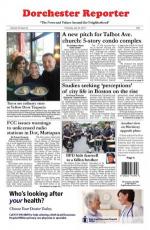May 12, 2011
UMass Boston officials, student representatives, and local neighbors gathered at the university’s scenic Campus Center ballroom Saturday to brainstorm ideas about the future of the campus and its impact on the city.
Attempting to answer the question of what to do with the property currently home to the Bayside Exposition Center, meeting organizers hoped to generate ideas and alternatives for the Columbia Point site. Materials handed out to guide the conversations stated that the “guiding principles” of the university’s development of the site would be to integrate Bayside with UMass’s strategic vision and master plan as well as to complement the city of Boston. According to organizers, other principles include utilizing the campus’s unique setting, improving environmental friendliness, and creating a “gateway between the city of Boston and Columbia Point,” while being respectful to the community and neighborhood.
Don Walsh, a Savin Hill resident and head of a mayoral task force focusing on development on Columbia Point, said he was optimistic that the meeting was a sign that the university will work with the community.
“There’s a chance that it’s nothing more than window dressing, and there’s the chance that it’s real, and I obviously hope that it’s real, but we’ll see. I have an open mind towards it,” Walsh said of the university’s newest overture to the community grassroots.
The university could raze the Expo building, which UMass officials have said is contaminated by asbestos and mold and would cost millions to bring up to code. Much of the talk at the meeting surrounded the potential of mixed-use developments on the site.
UMass purchased the property last year for $18.7 million and is using the site’s 20 acres as parking space for on-going construction projects.
Dorchester resident Jim Cawley said that his suggestion for the site would be to create a “university neighborhood” with “retail, housing on top, and they’re going to have to give up 25 percent of the housing to community members, not just straight students. That’s how they’re going to get it by [the neighbors].”
The day-long meeting began at 8:30 a.m. and continued well into the afternoon. Some 80 people, including UMass officials, community organizers, local stakeholders and other interested parties, engaged each other in a handful of discussion groups to brainstorm ideas. The architecture and urban design firm Stull & Lee produced maps and renderings to show how some of the options would appear.
Though billed as focusing on the Bayside site, the discussions often strayed to larger and more controversial subjects. Many neighborhood residents took the opportunity to bring up a perennial hot topic: dormitories. Former Fields Corner Civic Association president Tom Gannon, himself a UMass Boston grad, challenged the idea that dorms are necessary to the university’s mission, saying that UMass’s goal has always been to offer affordable high education for the residents of Greater Boston.
“[Students] came here ... because it’s a good education and it’s a good price and it’s easy to get to,” he told the Reporter after participating in one of the discussion groups.
UMass plan to assemble and publish a report on the meeting next month. Additional meetings, on a smaller scale, will be held to refine the suggestions in the report. After that, another meeting will take place in the fall with a final report will be issued by the end of the year.
UMass’s purchase and development of the Bayside site comes during a time of transition of Columbia Point as a whole. The construction of the Edward M. Kennedy Institute and the recent expansion of the JFK Presidential Library are reshaping the area. Planners expect to extend Mt. Vernon Street, which runs through the peninsula past the Bayside site and UMass, to the new institute.



